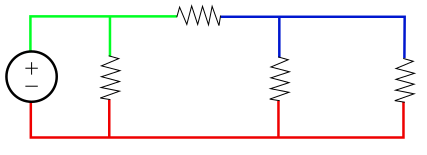|
Node (circuits)
 In electrical engineering, a node is any region on a circuit between two circuit elements. In circuit diagrams, connections are ideal wires with zero resistance, so a node consists of the entire section of wire between elements, not just a single point.[1] DetailsAccording to Ohm's law, V = IR, the voltage V across any two points of a node with negligible resistance R is showing that the electric potential at every point of a node is the same. There are some notable exceptions where the voltage difference is large enough to become significant:
Dots used to mark nodes on a circuit diagram are sometimes referred to as meatballs.[2] References |
